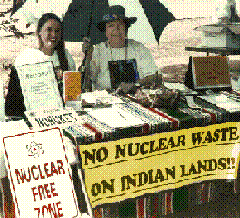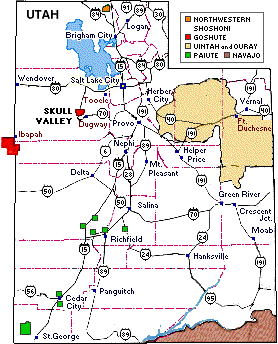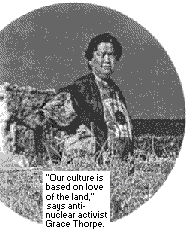

The Skull Valley Goshute Tribe signed an agreement to lease 820 acres of their reservation to a consortium of power companies called Private Fuel Storage. The land will be used as the site for a temporary storage facility for high level nuclear waste. The State of Utah, local ranchers, and certain members of the Goshute Indian Tribe oppose the introduction of a storage facility tot he reservation. Utah Governor Mike Leavitt contends that the state is already overburdened with nuclear waste, and the transportation of waste to the reservation would pose a threat to citizens. Some members of the tribe feel that the introduction of waste would be dangerous and would violate their traditional values. Opponents also fear that the temporary storage facility would end up becoming permanent. This fear results from the fact that the permanent site at Yucca Mountain, Nevada hasn't officially been confirmed and faces strong opposition. Members of the tribe who support the introduction of the facility feel that it would be a safe and economically beneficial endeavor. Supporters also contend the storage of nuclear waste is much safer than many toxic facilities and sites that already surround the reservation.

Under a treaty signed in 1863, the Skull Valley Goshutes gained tribal sovereignty giving them complete control over economic development on the reservation. Since 1989,l they have been actively pursuing nuclear waste storage. The office of the Nuclear Waste Negotiator (NWN) was established by the federal government in 1990 in an effort to find a location for a Monitored Retrievable Storage (MRS) facility for spent nuclear waste. The MRS would be used for the temporary storage of nuclear waste until the permanent sight at Yucca Mountain is completed. The NWN sent requests to all 50 states, eight territories, and 535 recognized Indian tribes. A total of 16 governments were accepted by NWN for Phase I of the study, each group received $1000,000 for acceptance. Members of the Tribe used this money and other federal grants to fund a world-wide tour of storage facilities. They also met with nuclear power experts to broaden their knowledge of nuclear waste storage. The majority of the applicants discontinued their proposals by the time Phase II of the process began, leaving only the Skull Valley Goshute Tribe and the Mescalaro Apaches of New Mexico. Each tribe received $2000,000 for Phase II of the study.
In 1993 of NWN program was closed by the government. In 1995 the government proposed a plan to build a temporary site next to the proposed permanent site at Yucca Mountain, regardless of the opinion of local residents. This plan failed, and the nuclear utilities began to take it upon themselves to find places to store their waste. The Skull Valley Goshutes and the Mescalaro Apaches continued to seek the possibility of storing waste. A group of 35 nuclear power utilities banded together to pursue the storing of waste with the Mescalaro Apaches. After internal conflict and a falling out in the Mescalaro tribe in late 1994, some of the utilities looked to the Skull Valley Goshutes. On December 27, 1996 they signed a lease with a group of utilities known as Private Fuel Storage (PFS). The Skull Valley Goshutes agreed to store up to 4000 casks of spent nuclear fuel, on 820 acres of Goshute land, for up to 25 years with the option for a 25 year extension. In return they would receive about $250 million in compensation. PSF has submitted an application to the Nuclear Regulatory Commission in order to obtain the necessary license to build the facility. It is expected to take two to three years for the application to be approved.
Back to Table of Contents The Skull Valley Goshute Tribe
The Skull Valley Goshute Tribe
 Private Fuel Storage (PFS)
Private Fuel Storage (PFS)
 Nuclear Regulatory Commission (NRC)
Nuclear Regulatory Commission (NRC)
 Leon Bear
Leon Bear
 Mike Leavitt
Mike Leavitt
 Merrill Cook
Merrill Cook
 Utah Department of Environmental Quality
Utah Department of Environmental Quality
 Dianne Nielson
Dianne Nielson
 Margene Bullcreek
Margene Bullcreek
 Ohngo Gaudadeh Devia
Ohngo Gaudadeh Devia
 The Confederated Tribe of Goshutes
The Confederated Tribe of Goshutes
 Local Ranchers
Local RanchersThe Skull Valley Reservation is located at the southern border of what is known as the Tooele County Hazardous Industries Zone, about forty miles southwest of Salt Lake City. This zone is home to the low-level waste dump, Envirocare. The Dugway Proving Ground was the sight of open air testing of chemical and biological weapons, and was the sight of an accident in the 1960s that killed 6,000 sheep on neighboring land. The military has been reluctant to disclose details of the accident, but they recently have begun a project to clean up the sight (Parker 1997). The area is also the sight of the Tooele Army Depot, which is home to 46% of U.S. chemical weapons awaiting incineration. Tooele County is home to Megacorp, the countrys third worst polluter, which releases 100 tons of chlorine into the air every day. Other polluters in the area include: The Laidlaw Grassy Mountain hazardous waste disposal sight and incinerator, and the Aptus hazardous waste incinerator.
Only 30 members of the tribe reside in a small village located on the reservation. The village consists of few homes and trailers, many of which are abandoned (Woolf 5 Oct. 1997)
Margene Bullcreek, the main tribal opponent, is currently fighting to keep the facility off the reservation. In June of 1997, she organized a 65 mile run from the Skull Valley reservation to Salt Lake to protest the storage facility. On August 16, 1997, a public forum concerning nuclear waste storage was held. Speakers included Fred Malar and Native American activist Grace Thorpe.  Fred Malar has been active in the fight against a Northern States Power Plant in Prairie Island, Minnesota. The organization Ohngo Gaudadeh Devia filed a petition with the NRC to intervene in the sighting of the storage facility. This petition argued that the storage facility would violate their cultural values. On November, 24, 1997, Ohngo Gaudadeh Devia filed a contention with the NRC arguing that having a storage facility on the reservation would obstruct their peace. According to Margene Bullcreek, Ohngo Gaudadeh Devia is considering using arguments for environmental injustice to continue their fight against the PFS facility (1997).
Fred Malar has been active in the fight against a Northern States Power Plant in Prairie Island, Minnesota. The organization Ohngo Gaudadeh Devia filed a petition with the NRC to intervene in the sighting of the storage facility. This petition argued that the storage facility would violate their cultural values. On November, 24, 1997, Ohngo Gaudadeh Devia filed a contention with the NRC arguing that having a storage facility on the reservation would obstruct their peace. According to Margene Bullcreek, Ohngo Gaudadeh Devia is considering using arguments for environmental injustice to continue their fight against the PFS facility (1997).
Utah governor Mike Leavitt strongly opposes the storing of nuclear waste in Utah. He feels that the transport of waste through the state would put citizens in danger. He also feels that, since Utah doesn't produce or consume nuclear energy, they shouldn't have to store the waste derived from it. In the spring of 1997 Governor Leavitt developed a six step strategy to combat the facility at Skull Valley (Woolf 16 April 1997).
On April 15, 1997, the Task Force Opposing High Level Nuclear Waste was created in response to an Executive Order by the governor. On June 27, 1997, this department submitted a petition to the NRC, stating that PFS failed to comply with requirements to allow emergency response organizations sixty days to comment on their emergency plan prior to submitting their application (DEQ Homepage 1997)> On July 21st, they submitted another petition with NRC. The petition urged the commission to reject PFS's application for a license to store nuclear waste on the Skull Valley Reservation, and stated that application was "devoid of substantive detail" (qtd. In Woolf 1997). The application was said to lack sufficient detail on issues of finance and methods of transportation. On September 11, another petition was submitted to the NRC to request a formal hearing on the issue and that the State of Utah be allowed to participate in the licensing proceedings. According to Connie Nakahara, of the Utah Department of Environmental Quality, these petitions were dismissed by the NRC on the grounds that this type of petition is "for enforcement purposes only, not for licensing proceeding" (1997).
In June of 1997, Utah Representative Merrill Cook filed legislation to amend the Hazardous Waste Transportation Act in order to develop penalties for the transport of spent fuel to the reservation.
To justify environmental impact of the storage facility, Leon Bear contends that there are other more dangerous toxic sights surrounding the reservation. The state shouldn't be so concerned with the introduction of a comparatively safe nuclear waste storage facility. He also states that there have been no problems with other facilities of its kind.
It is proving very difficult for the Department of Environmental Quality to intervene in the sighting process since they have no authority over matters of tribal sovereignty. They have focused their arguments on issues of transportation, or which they do have authority.
Ohngo Gaudadeh Devia consists of members of the tribe, which puts it in a position to dispute the introduction of the facility. They have made their feelings on the facility known to the NRCF, but since tribal leaders are in charge of decision making, their opinion has little effect on the NRC's decision to allow construction. If Ohngo Gaudadeh Devia decides to take legal action against PFS, bringing forth issues of environmental justice may prove successful.
Leon Bear has brought forth the issue that the area around the reservation has been exposed to hazardous sites for a long time, and it has long been ignored. Since the state is putting so much effort in stopping the transportation of waste through the state, Mr. Bear's observation exposes the possibility that there is a disproportionate concern for environmental hazards according to their location in the state of Utah.
Back to Table of ContentsSince the NRC has rejected all attempts to expose flaws in the licensing procedure undertaken by PFS, groups opposing the facility should take a new direction in organizing opposition tactics. Issues of environmental justice may be effective in out weighing issues of tribal sovereignty. Questioning the ethics behind the disproportionate targeting on Indian reservations as locations to store nuclear waste may be effective. The morality in the act of using large sums of money to entice the economically burdened to accept waste should also be examined. As a long-term solution to the problems resulting from nuclear energy, I feel that NECONA put it best when they stated: "Nothing is to be manufactured, used, or reproduced in the United States that cannot be safely disposed of" (qtd. In Thorpe 1995). This statement was contained in a bill proposed to Congress in 1995.
Back to Table of Contents Margene Bullcreek
(801) 831-4614
Bullcreek, Margene. Personal Interview. 24 Nov. 1997.
Nakahara, Connie. E-mail to the author. 26 Nov. 2997.
Parker, Cherie. "NSP's Skull Valley Duggery." NECONA. Jan. 1997. Netscape. Internet. 23 Oct. 1997.
State of Utah. Department of Environmental Quality Homepage. 1997. Netscape. Internet. 1 Dec. 1997.
Thorpe, Grace. "Our Homes Are Not Dumps: Creating Nuclear-Free Zones." NECONA. 17 March 1995. Netscape. Internet. 15 Nov. 1997.
Woolf, Jim. "Utah Tribe Wont Dump Plan For." Salt Lake Tribune Archive. 16 April 1997: Al. Netscape. Internet. 15 Oct. 1997.
Woolf, Jim. "Nuclear Storage; Goshute DefenÉ" Salt Lake Tribune Archive. 5 October 1997: Al. Netscape. Internet. 5 Oct. 1997.